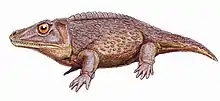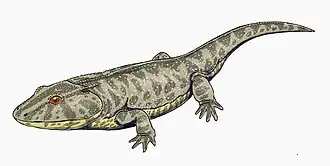| Siderops | |
|---|---|
 | |
| Holotype skeleton | |
| Scientific classification | |
| Domain: | Eukaryota |
| Kingdom: | Animalia |
| Phylum: | Chordata |
| Class: | Amphibia |
| Order: | †Temnospondyli |
| Suborder: | †Stereospondyli |
| Family: | †Chigutisauridae |
| Genus: | †Siderops Warren and Hutchinson, 1983 |
| Species: | †S. kehli |
| Binomial name | |
| †Siderops kehli Warren and Hutchinson, 1983 [1] | |
Siderops (from the Greek sideros meaning “iron” and -ops meaning “face”) is an extinct genus of chigutisaurid temnospondyl from Early Jurassic of Australia, containing the species S. kehli (named after the Kehl family of ‘Kolane’, Wandoan, Queensland where the fossil was found).
Discovery
It is solely known from the holotype specimen, which consists of a nearly complete skull with mandible and postcrania were found within the Westgrove Ironstone Member of the Evergreen Formation of the Surat Basin in Queensland.[1] Dating to the late Toarcian at approximately 176.6 ma.[2] Siderops was large, with a skull width 70 cm (28 in) wide and a total length of 2.6–2.7 m (8.5–8.9 ft).[3][4]
Classification
Siderops belongs to the clade Brachyopomorpha, a subdivision of the greater clade Temnospondyl and placed in the superfamily Brachyopoidea and belonging in the Chigutisauridae family.[1] Shown below is a cladogram of Brachyopoidea adapted from Warren et al. (1983) and Ruta et al. (2007).[1][5]
| Brachyopoidea |
| ||||||||||||||||||||||||||||||||||||||||||||||||||||||||||||
References
- 1 2 3 4 Warren, A. A.; Hutchinson, M. N. (1983). "The Last Labyrinthodont? A New Brachyopoid (Amphibia, Temnospondyli) from the Early Jurassic Evergreen Formation of Queensland, Australia". Philosophical Transactions of the Royal Society B: Biological Sciences. 303 (1113): 1–62. Bibcode:1983RSPTB.303....1W. doi:10.1098/rstb.1983.0080. Retrieved 30 March 2022.
- ↑ Todd, Christopher N.; Roberts, Eric M.; Knutsen, Espen M.; Rozefelds, Andrew C.; Huang, Hui-Qing; Spandler, Carl (December 2019). "Refined age and geological context of two of Australia's most important Jurassic vertebrate taxa (Rhoetosaurus brownei and Siderops kehli), Queensland". Gondwana Research. 76: 19–25. Bibcode:2019GondR..76...19T. doi:10.1016/j.gr.2019.05.008. S2CID 199105458.
- ↑ Steyer, J. Sébastien; Damiani, Ross (2005-05-01). "A giant brachyopoid temnospondyl from the Upper Triassic or Lower Jurassic of Lesotho". Bulletin de la Société Géologique de France. 176 (3): 243–248. doi:10.2113/176.3.243. ISSN 0037-9409.
- ↑ Hart, Lachlan J.; Gee, Bryan M.; Smith, Patrick M.; McCurry, Matthew R. (2023-08-03). "A new chigutisaurid (Brachyopoidea, Temnospondyli) with soft tissue preservation from the Triassic Sydney Basin, New South Wales, Australia". Journal of Vertebrate Paleontology. doi:10.1080/02724634.2023.2232829. ISSN 0272-4634.
- ↑ Ruta, M.; Pisani, D.; Lloyd, G. T.; Benton, M. J. (2007). "A supertree of Temnospondyli: cladogenetic patterns in the most species-rich group of early tetrapods". Proceedings of the Royal Society B. 274 (1629): 3087–3095. doi:10.1098/rspb.2007.1250. PMC 2293949. PMID 17925278.














